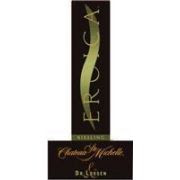
So last night I was back at Wine Class after a rather lengthy hiatus.
The session was The Great Rieslings of the World, but it was not quite as great as I had anticipated.
(but I did pick up, as I had previously hoped, a few nuggets of wisdom)
Now as most of you probably already know (I did not), Riesling originated in Germany. (the Riesling varietal is actually a hybrid of a grape most likely introduced by the Romans, crossed with another, German grape)
German wine labels can be a bit tricky to read (however, more concise than most, thanks to strict German labeling laws), but by memorizing a few of these useful references, you'll be able to easily make a prudent decision when buying German wines.
First and foremost, never buy anything labeled as Tafelwein, meaning Table Wine.
(you should never buy Table Wine anyway, no matter what the country!)
The next, riper grade, above Tafelwein is Qualitätswein (Quality Wine) or QbA.
These will be your leaner wines with, more likely than not, sugar added (due to low ripeness) in order to boost its alcohol content.
Yep, you guessed it: Qualitätswein is not so qualititious after all.
Next is Kabinett.
Kabinett wine is not so bad--it's wine that you keep in your cabinet.
(that's all I have to say about that one)
Next, Spätlese (shpet-layzeuh).
Spätlese wines are made from grapes which have remained on the vine longer, resulting in riper grapes.
Auslese - selected.
Above Auslese, BA or Beerenauslese - berry selected.
Getting even riper now, TBA or Trockenbeerenauslese - dry berry selection.
In these three final grades are instances where the the grapes have been left on the vine longer, sometimes even unto the point of moldiness and/or raisin-like shriveling, hence, giving you a much fruitier and heavier wine.
Then there's also Eiswein (Ice Wine) - the process of squeezing frozen grapes, where the water remains frozen in the grape, hence giving a very rich, nectar-like substance.
(BA's and TBA's are usually only sold in half bottles and can be quite expensive)
All ripenesses from Spätlese up to TBA fall under the category of Qualitätswein mit Prädikat, meaning quality wine with an attribute. (think A.O.C.) And BA's and TBA's will be your dessert wines (TBA also being Eiswein).
But, if pressed, and had to pick a favorite from this class, I'd go with the Columbia Valley, Riesling, 'Eroica,' Dr. Loosen, Château Ste. Michelle 2008.
This particular Riesling comes from Washington state, but don't let that deduce your opinion of its quality; nowadays, good Rieslings can be found from places all around the world from New Zealand to Chile to Canada (Canada makes some nice Ice Wines as well). Additionally, Château Ste. Michelle is a well known maker of elegant, quality wines.
Château's Riesling is definitely one of your sweeter Rieslings--but not cloyingly sweet, and yet, pleasantly lean. There's even a slight touch of effervescence and some acid to it.
At first taste, I thought I'd enjoy it better chilled, as an apéritif, but after tasting it again, with some goat cheese, I found its temperature perfectly suitable and it really opened up the fruitiness. At a mere $22, not bad at all. A nice start to a light summer meal, I'd say.
 > >
> >

1 comment:
So happy school is back is sesh for you! Teach me oh wise one...
Post a Comment